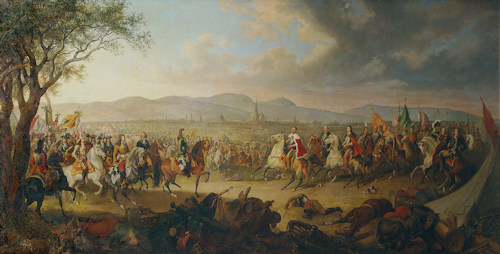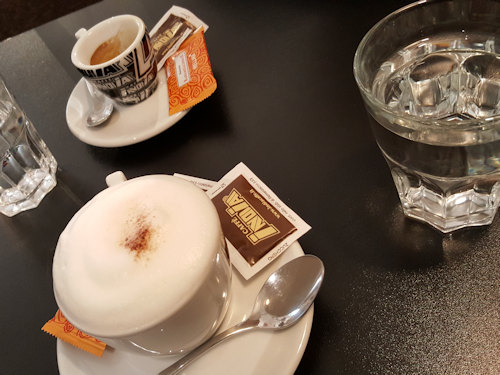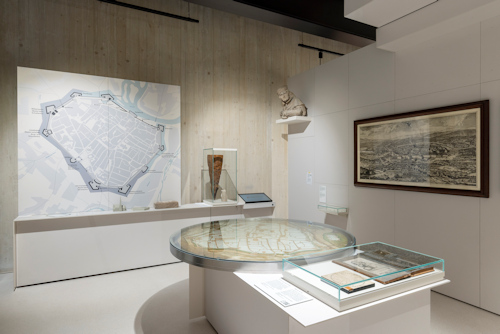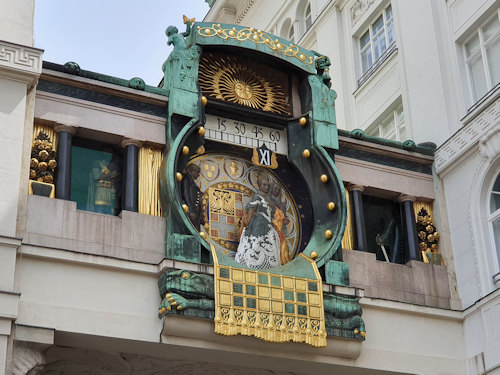A pivotal moment in Vienna’s long past came in 1683 when the Ottoman Empire laid siege to the city. The outcome changed the course of Austrian and European history and gave birth to numerous stories (and myths).
- Siege lasted around two months
- The Polish king, Jan III Sobieski, eventually relieved the city
- Marked the beginning of the end for the Ottomans in Europe
- Allegedly the origins of Vienna’s association with coffee
- Echoes of the siege still found in Vienna’s old town
- See also:
The Ottoman siege

(Karl von Blaas, The Defence of Vienna against the Turks 1683, from around 1685, oil on canvas, 65 x 48 cm, Belvedere, Wien, Inv.-Nr. 2731; Photo courtesy of and © Belvedere, Wien. Reproduced with permission under the terms of Creative Commons License CC BY-SA 4.0. )
One of the great disputes in European history was the war between the Habsburgs and the Ottoman empire, an on-off conflict that began in the early 16th century and lasted almost 300 years.
The Ottomans, centered in modern-day Turkey, conquered large chunks of southeastern Europe during that time, including various Habsburg dominions.
For example, Suleiman the Magnificent’s military endeavours saw the Ottoman empire expand to include much of today’s Hungary and took him right to the city limits of Vienna in 1529 (the first Siege of Vienna).
Suleiman failed to breach the defences and, with winter coming, called it quits and returned home.
But the second siege of Vienna interests us more, being a rather pivotal event in European and Viennese history.
Like most empires, the Ottomans went through peaks and troughs of size, power and influence. After a less than stellar first few decades in the 1600s, they found themselves on the up again in the 1680s.
And so the Ottomans sought to succeed where Suleiman failed and set off to capture Vienna: a true jewel of the continent and a vital strategic and trade asset.

(The battle at the Burg bastion by Romeyn de Hooghe (Artist), Nicolaes Visscher (II.) (publisher); Nr. 5 in a series from 1683–1684, Wien Museum Inv.-Nr. 111017/5; excerpt reproduced with permission under the terms of the CC0 licence)
To cut a long story short, Grand Vizier Kara Mustafa Pasha laid siege to the city on July 14th, 1683, with an army that far outnumbered the defenders.
The Habsburg emperor of the time (Leopold I) had already left town with a hastily-assembled overnight bag and an urgent appointment somewhere with fewer people likely to point sharp objects at him.
Leopold’s departure hardly counted as a ringing endorsement of Vienna’s defensive prospects; things did indeed look grim for the city.
Remarkably, though, the fortifications and the Viennese held firm long enough for a relief army to arrive in early September, led by the Polish king, Jan Sobieski.
Forces from the Polish-Lithuanian commonwealth, various states within the Holy Roman Empire, and Habsburg territories defeated the Ottoman army comprehensively.
The end of the siege marked the beginning of the end for Ottoman incursions and rule in Europe. Historians consider it the major turning point in the long conflict between the two powerful factions, one that saw the Ottomans eventually beaten back to their more traditional borders.
Why is it important?

(Johann Nepomuk Höchle, Emperor Leopold I. and King Jan III. Sobieski in front of Vienna, undated, oil on canvas, 228 x 448 cm, Belvedere, Wien, Inv.-Nr. 7957; Photo courtesy of and © Belvedere, Wien. Reproduced with permission under the terms of Creative Commons License CC BY-SA 4.0.)
The siege ranks as one of Europe’s most significant Sliding Doors moments.
The fall of the city in 1683 certainly would have dealt a major blow to Habsburg hegemony. Defeat would have led to greater Ottoman influence in Europe, whose map and culture would no doubt be considerably different today.
The close encounter with the Ottomans also left a long-lasting psychological mark on the town.
For the administrative centre of a centuries-old empire, Vienna has led a relatively peaceful existence. As such, major conflicts involving the city – like the 1683 siege – tend to stick in the cultural memory.
Vienna’s liberation (or conquest, depending on your perspective) at the end of WWII offers another more recent example.
I also have the impression the siege and wider conflict left a grudging respect for another, quite different, culture.
And the event inspired a seemingly unshakeable myth about the origins of Vienna’s cosy relationship with coffee.
Coffee?

(The city’s favourite drink)
According to legend, when the local population emerged from the city to investigate the abandoned Ottoman encampment, they discovered sacks of mysterious dark beans belonging to the invaders.
And so coffee arrived in Vienna, beginning a long tradition that continues today.
A nice story, but simply not true.
The myth may have come about since the first formal coffee house in Vienna opened within a year or two of the siege. That privilege went to the Armenian, Johannes Deodat, in 1685.
Other cities in Europe already had coffee houses by that time. For example, London’s first opened over 30 years before Ottoman cannons pointed at Viennese walls. So it seems highly unlikely that coffee arrived in Vienna as a complete unknown.
Another likely myth is that the siege indirectly gave rise to the croissant.
Allegedly, a baker created the crescent-shaped Kipfel to celebrate the victory. Whatever its origin, this baked item eventually found its way to Paris in the early 1800s and likely inspired the creation of the croissant.
Where to learn/see more

(Representations of the city fortifications in the Wien Museum main building on Karlsplatz; ; press photo © Lisa Rastl)
Two museums have areas dedicated to the conflict:
- The permanent exhibition of the Wien Museum covers the chronology and culture of the city. One section looks at the period around the siege but also tackles the topic in the context of information management and controlling narratives
- The Museum of Military History has a gallery that deals with some of the Ottoman conflicts, particularly the role of Prince Eugene in pushing the Ottomans out of Europe in the years that followed the siege. View numerous Ottoman army artifacts and a large format painting of the relief battle.
Remnants of the siege and references to the victory also pepper Vienna. For example:
- A few pieces of the old city walls that held firm against the Ottoman cannons and sappers remain today (most of the fortifications disappeared in the late 19th century to make way for the Ring boulevard and various prestigious building projects).
- The 5D cinematic experience within the Time Travel tour includes a part dedicated to the siege.

(The Sobieski plaque)
- A plaque outside the Augustinerkirche commemorates the mass that Sobieski attended in the church after lifting the siege.
- A golden ball hanging outside No.11 on Am Hof square turns out to be an Ottoman cannonball from 1683. People still dig up the occasional cannonball today.
- One of the panoramas in the display hall beneath the giant Ferris wheel deals with the siege.

(The Jugendstil Ankeruhr)
- Two of the figures on the famous Ankeruhr giant mechanical clock honour participants in the defence of Vienna:
- The mayor at the time, Johann Andreas von Liebenberg
- The head of the defending forces, Ernst Rüdiger von Starhemberg
- Both people also have monuments in their name: Starhemberg has a statue in the park outside city hall. And the Liebenberg monument is on the Ringstrassen close to the main university building.
